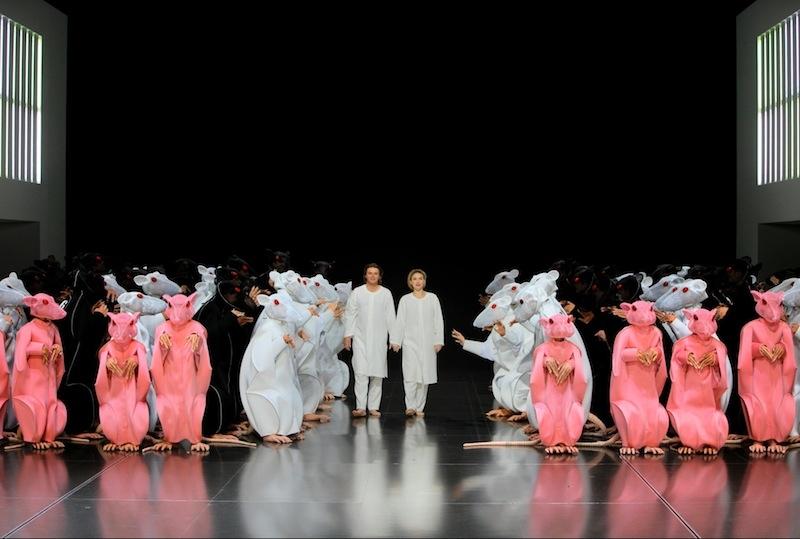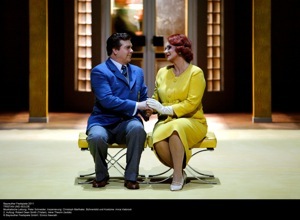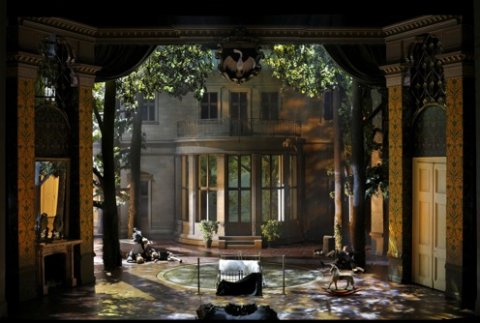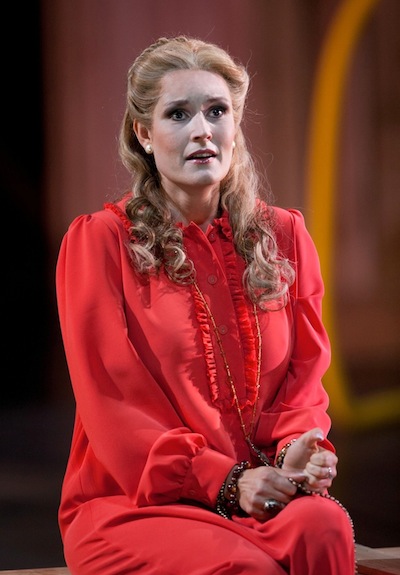theartsdesk in Bayreuth: Wagner in the Laboratory | reviews, news & interviews
theartsdesk in Bayreuth: Wagner in the Laboratory
theartsdesk in Bayreuth: Wagner in the Laboratory
Music drama suffers from visual fantasy and the angst of German history

Richard Wagner has probably only himself to blame if his operas have become a laboratory for the testing-to-destruction of the intellectual preoccupations of that Opera Führer of our time, the stage director. Wagner it was, after all, who transferred the mythic concept of concealed meaning to the opera house: Wagner who recreated legend as psycho-social allegory, and made musical narrative the handmaiden of philosophy and political ideology.
Not much, I should like to think – but I’m by no means entirely confident. Some case studies from the 2011 festival. In Hans Neuenfels’s production of Lohengrin (the tale of a young girl wrongly accused of murdering her brother, who marries her champion but fails the test of not asking his identity), the Brabantian and Saxon nobles, ladies etc, are mainly presented as a chorus line of black, white, pink and yellow rats, because – Neuenfels explains – it’s necessary to disrupt the smooth heraldic surface of the medieval setting with something that “outdoes the bizarre”.
In Die Meistersinger von Nürnberg Katharina Wagner, the composer’s great-granddaughter and now co-director of the festival, portrays the Masters in the final act procession as a line-up of hideously masked German geniuses (including Wagner himself) in boxing shorts and with exposed erect penises.
 In Act II of Tristan und Isolde, on the other hand, the erotic lovers are the sort of tidy middle-aged couple you might meet on an American tour bus, and their nocturnal love-play is conducted on a pair of yellow stools in what looks (and feels) like a well-lit Soviet sports hall (the lovers pictured left by Enrico Nawrath).
In Act II of Tristan und Isolde, on the other hand, the erotic lovers are the sort of tidy middle-aged couple you might meet on an American tour bus, and their nocturnal love-play is conducted on a pair of yellow stools in what looks (and feels) like a well-lit Soviet sports hall (the lovers pictured left by Enrico Nawrath).
The Minstrels' Hall in Tannhäuser is reimagined by Sebastian Baumgarten as a biogas recycling plant alias (of course) an extermination camp, and Venus – doing her own bit of recycling – pops up at the end with a nice middle-class baby.
Finally Parsifal, Wagner’s complex allegory of Christian suffering and redemption, is used by Stefan Herheim as a platform for a broad re-enacting of German history over the last 100 years, interwoven with the story of Bayreuth itself and coloured in with some lurid speculations about Parsifal’s relationship with his mother and Kundry’s relationship with pretty well everyone. There’s an uncanonical baby here, too; we (perhaps) witness its conception, attend its birth and observe its abduction (by Kundry in the unexpected guise of a housemaid). But exactly why it’s there at all remains something of a mystery.
One has to keep reminding oneself, through all these fantasies, that Wagner was also the apostle of the intimate relationship between music and text: that the idea of the integrated artwork lay at the heart of the revolution he saw himself as carrying through in opera. As Patrick Carnegy pointed out in his Wagner and the Art of the Theatre, this needn’t be taken to mean that he would have been hostile (as his widow, Cosima, certainly was) to any new ideas as to how his works might be staged after his death.
But one would like to feel that he would have jibbed at this wholesale deconstruction of his plots, even if – as far as I can judge – Bayreuth continues to perform his music and (with the odd exception) his words in exemplary fashion. In fact, the authenticity of what one hears if anything draws attention to the perversity of what one sees. I’ll come back to the quality of what one hears a little later. I suspect there’s a connection here, but it’s a pragmatic rather than a philosophical one.
![]() One can go on about Director’s Theatre, but Bayreuth is a very special case. You can travel around in Germany and not be aware of anything particularly odd about its past. But the minute you enter a theatre the past starts buzzing round you like an angry hornet. This will be Germany’s past. But at Bayreuth, Germany’s past is hopelessly entangled with its own. No need to dwell on all this: Winifred Wagner’s involvement with Hitler, the implications this had for the works themselves, the postwar recriminations, the interminable Wolfgang Wagner régime, the family battles over his successor.
One can go on about Director’s Theatre, but Bayreuth is a very special case. You can travel around in Germany and not be aware of anything particularly odd about its past. But the minute you enter a theatre the past starts buzzing round you like an angry hornet. This will be Germany’s past. But at Bayreuth, Germany’s past is hopelessly entangled with its own. No need to dwell on all this: Winifred Wagner’s involvement with Hitler, the implications this had for the works themselves, the postwar recriminations, the interminable Wolfgang Wagner régime, the family battles over his successor.
These battles, I suppose, are still going on. They’re reflected, surely, in the flailing, sophomoric imagery of the 33-year-old Katharina’s Meistersinger (Act III pictured above right by Enrico Nawrath) and in the fact that, as is rumoured, she has subsequently been under pressure to restrict herself to managerial activities. But every one of these productions reflects, in one way or another, the seemingly unassuageable Bayreuth angst. In a nutshell, the past has not gone away, perhaps will never go away, and must be eternally and unconditionally fought.
Yet for a house dedicated to the perpetuation of a single composer’s works, this is an impossible, self-contradictory proposition. The Wagners are like the drop-out heir to a stately home who justifies keeping it by converting it into a drug-dependency unit and letting the park off for raves.
The fact that their particular inheritance is the work of a candid nationalist and anti-Semite, loaded with xenophobic, militaristic concepts and images subsequently embraced by the country’s Nazi wreckers, obviously doesn’t make things any easier. You shouldn’t be able to perform Wagner in the new Germany, but you must perform him, if only in a distorted form that actually presents him in a far more damaging light than is remotely justified by a cool study of his work.
The lengths to which these evasions will go sometimes beggar belief. In Meistersinger Katharina Wagner offers us a Walther von Stolzing who is apparently not even a composer, but a painter who, for some obscure reason, has to prove himself by writing and singing songs. Presumably this is a confused way of dodging the whole issue of the German Great Tradition, which is, naturally, its music.
Unfortunately it has the unwanted side-effect of making it harder for Burkhard Fritz to focus on singing the role, since he must all the time be daubing paint here and there, like some maniac graffiti artist. He even graffitis Eva (poor, drably directed Michaela Kaune); he empties a whole pot of paint over the unprotesting Masters’ table; and while “composing” his Morning Dream he paints the scenery slats of a toy theatre, an ironic comment on a stage that seldom, if ever, boasts such an old-fashioned accessory.
Some of this, admittedly, is a sign as much of inexperience as of Bayreuthian neurosis. Fräulein Wagner clutters the stage with superfluous action, one feels, because she hasn’t learnt to let the music speak for itself. And she satirises her characters one-dimensionally, like an undergraduate writing a revue sketch. The Masters, especially, are ruined by this device, which undermines the whole point of Wagner’s deeply humane sympathy for these “men of honour” (as Sachs calls them) “who make mistakes and are content that one take them on their own terms”.
![]() Even Sachs himself starts out in this way, treating his fellow Masters at first with open contempt, but recovers thanks to James Rutherford’s benign stage presence and fine, if as yet not wholly projected, singing (Rutherford as Sachs pictured left by Enrico Nawrath).
Even Sachs himself starts out in this way, treating his fellow Masters at first with open contempt, but recovers thanks to James Rutherford’s benign stage presence and fine, if as yet not wholly projected, singing (Rutherford as Sachs pictured left by Enrico Nawrath).
This Meistersinger is perhaps a special case. It’s hard to believe that Katharina Wagner would be let loose in a major international opera house that hadn’t been built by an ancestor. But the evasions mount elsewhere too.
Why would one direct Tristan und Isolde in the bloodless, municipal, electric-lit style adopted by Christoph Marthaler, if not to distance oneself from the psychotic excesses of Wagner’s scenario, and in particular its regrettable praise of darkness? “The dreary day for the last time,” Tristan laments as King Mark interrupts their nocturnal love-making, while outside (like most modern directors Marthaler sets everything indoors) the day actually fades into darkness.
Again, it’s a reading that gives the singers minimal support. It would be harsh to blame the director for Robert Dean Smith’s loss of voice halfway through the opera’s fearsome last act. But dryness of spirit is certainly no lubrication for vocal effusion. Nor does it help the kind of total engagement that might prevent the moments of unease (including one horrid missed entry) that marred Iréne Theorin’s generally superb Isolde, on the whole the best singing we heard all week.
The denial of sensual charm is in fact a recurrent phenomenon of these stagings. Wherever the drama requires beauty or splendour, ugliness and degradation are the predictable response: Venus (in Tannhäuser) as a heavily pregnant housewife in silver lamé, her naiads as hairy Neanderthals with bare bottoms, King Henry (in Lohengrin) as a gibbering, sub-Pirandellian idiot. Any conceivable representative of power or authority is routinely parodied (by, one notes in passing, stage directors wielding power and authority).
To take the extreme case, soldiers are virtually banned from the Bayreuth stage, unless goose-stepping and swastika-bedecked, like Klingsor’s troops in Act II of Parsifal, or as the corpses of the Flower Maidens’ husbands flung unceremoniously onto the stage earlier in the same act. But at least it’s now the bad guys who are tarred with the Nazi brush, rather than the Knights of the Grail, as often in the past. This is, I suppose, progress of a kind.

As an extreme example of Bayreuthian navel-gazing, Herheim’s Parsifal (spectacularly realised by designer Heike Scheele [pictured above]) surely takes the biscuit. By setting the “Stage Consecration Festival” in the composer’s own Villa Wahnfried (itself at present, aptly enough, closed for renovation), Herheim implicitly sanctifies the Wagnerian succession, but in a studiedly perverse way. If the composer’s house is the Temple of the Grail, then the child Parsifal in a sailor suit is – well, who? Herzeleid, his mother, is – who? The baby delivered, with sickening realism, in the third act is – who? And so on.
None of this sheds much light on the central issue of Parsifal – the question of atonement. Instead it replaces it with an Oedipus problem. Parsifal loves his mother (physically on occasion), Kundry and Herzeleid (who doesn’t appear in Wagner) are interchangeable, as are Herzeleid and Amfortas, dimly understood as Parsifal’s father (whom he heals with his spear, but then displaces).
In the final act Parsifal appears in the new Grail Temple, the Bundestag, in the guise of a white-robed priest with flowing red locks. Healing Amfortas, he heals Germany – an atonement of sorts. At this point, with almost unbelievable banality, Herheim turns a huge mirror on the audience – a cliché so tired that one can scarcely credit its use by a sophisticated director in the year 2011.
Yet in some respects this audience gets what it deserves. They (we) are a strikingly complicit bunch of fat cats. They watch themselves and their prosperity being viciously satirised; they witness every value they hold dear being perverted; they hear some of their finest masterpieces being used as a vehicle for guilt-ridden dissociation from their past and their present: and they cheer. Or if, from time to time, they boo, the ritual is somehow enhanced, never disrupted. This, one feels, is why they came; and why they will come again. At €220 a ticket, they are entitled to enjoy themselves.
How, though, does Wagner come out of all this? Well enough for most people, is the answer, but not as well as his work deserves in the one house in the world best equipped to present it.
To put it bluntly, the musical standards are those of a decent provincial German opera house, which in a sense is what it is. The (very large) chorus is generally excellent, with some rough edges – excusable in view of the complicated and sometimes gratuitous manoeuvres they are called on to perform while singing this demanding music. The orchestral playing, very fine in Tannhäuser (the one new production), was variable elsewhere – good, but not the best. Of course, playing Wagner five nights a week under five different conductors is no joke. Sometimes they must have to pinch themselves to remember which night it is.
As for the solo castings, one is mildly conscious that this is not where the (heavily subsidised) big money is being spent. You observe the complex sets and the elaborate and colourful costuming of the 150-strong chorus, and you suspect that the visual factor has taken precedence, along with the production values, over the actual music – which is perhaps not quite what Wagner meant when he talked about “musical deeds rendered visible”.
 The best soloists are strong: Theorin’s Isolde, Robert Holl’s King Mark, Fritz’s Walther (when he can tear himself away from his daubings), Georg Zeppenfeld’s Pogner and King Henry, Petra Lang’s Ortrud, Camilla Nylund’s Elisabeth (pictured right). But there is also a good deal of undercasting. A number of singers struggled to cope with the huge stage and auditorium, even with the orchestra canopied, which, for top Wagnerians, has usually solved the problem of balance. In many opera houses, some of these voices would scarcely be heard at all.
The best soloists are strong: Theorin’s Isolde, Robert Holl’s King Mark, Fritz’s Walther (when he can tear himself away from his daubings), Georg Zeppenfeld’s Pogner and King Henry, Petra Lang’s Ortrud, Camilla Nylund’s Elisabeth (pictured right). But there is also a good deal of undercasting. A number of singers struggled to cope with the huge stage and auditorium, even with the orchestra canopied, which, for top Wagnerians, has usually solved the problem of balance. In many opera houses, some of these voices would scarcely be heard at all.
The conductor, at Bayreuth, can easily disappear altogether. He gets no welcome, and takes no bow until the very end. The days of the Wagner maestro, from Richter to Boulez, are long gone. In their place are a quintet of expert functionaries. Thomas Hengelbrock’s Tannhäuser I’ve already praised on this site. Peter Schneider conducted an often beautiful, if somewhat one-paced Tristan, with a superb surge in the third act just when Robert Dean Smith was starting to fade. But Daniele Gatti’s Parsifal was for my taste too slow, and Andris Nelsons’ Lohengrin too workaday, without the urgency this score needs if it’s to avoid the mauvais quarts d’heure that Rossini grumbled about. In Meistersinger, Sebastian Weigle did well to bring some focus to Katharina Wagner’s and her designer Tilo Steffens’s diffuse stage picture; but for the most part it was a losing battle.
Bayreuth remains a unique experience for the lover of Wagner’s music. The theatre is still his theatre, the music his music. But it’s harder than it once was to feel that his work is being served here by people who have its interests at heart as opposed to the need to position themselves in relation to events that stand between it and them and often shut out its light.
Perhaps it’s naïve to expect things to be otherwise. Wagner, too, had an acute sense of history, and would certainly have written these dramas very differently 100 years later. But that’s a mere platitude. Another, better platitude is that he wrote what he wrote, and that the real challenge is to accommodate these texts to the needs of the hour without redefining their dramaturgies. Others have proved that this is perfectly feasible. Bayreuth needs to come to its senses and reassert its natural role as the Stratford-upon-Avon of Wagner production.
Add comment
The future of Arts Journalism
You can stop theartsdesk.com closing!
We urgently need financing to survive. Our fundraising drive has thus far raised £33,000 but we need to reach £100,000 or we will be forced to close. Please contribute here: https://gofund.me/c3f6033d
And if you can forward this information to anyone who might assist, we’d be grateful.

Subscribe to theartsdesk.com
Thank you for continuing to read our work on theartsdesk.com. For unlimited access to every article in its entirety, including our archive of more than 15,000 pieces, we're asking for £5 per month or £40 per year. We feel it's a very good deal, and hope you do too.
To take a subscription now simply click here.
And if you're looking for that extra gift for a friend or family member, why not treat them to a theartsdesk.com gift subscription?
more Opera
 Help to give theartsdesk a future!
Support our GoFundMe appeal
Help to give theartsdesk a future!
Support our GoFundMe appeal
 Peter Grimes, Welsh National Opera review - febrile energy and rage
In every sense a tour de force
Peter Grimes, Welsh National Opera review - febrile energy and rage
In every sense a tour de force
 Owen Wingrave, RNCM, Manchester review - battle of a pacifist
Orpha Phelan brings on the big guns for Britten’s charge against war
Owen Wingrave, RNCM, Manchester review - battle of a pacifist
Orpha Phelan brings on the big guns for Britten’s charge against war
 Tales of Apollo and Hercules, London Handel Festival review - compelling elements, but a failed experiment
Conceptually the two cantatas just don't work together
Tales of Apollo and Hercules, London Handel Festival review - compelling elements, but a failed experiment
Conceptually the two cantatas just don't work together
 La finta giardiniera, The Mozartists, Cadogan Hall review - blooms in the wild garden
Mozart's rambling early opera can still smell sweet
La finta giardiniera, The Mozartists, Cadogan Hall review - blooms in the wild garden
Mozart's rambling early opera can still smell sweet
 Der fliegende Holländer, Irish National Opera review - sailing to nowhere
Plenty of strong singing and playing, but the staging is static or inept
Der fliegende Holländer, Irish National Opera review - sailing to nowhere
Plenty of strong singing and playing, but the staging is static or inept
 Die Zauberflöte, Royal Academy of Music review - first-rate youth makes for a moving experience
The production takes time to match Mozart's depths, but gets there halfway through
Die Zauberflöte, Royal Academy of Music review - first-rate youth makes for a moving experience
The production takes time to match Mozart's depths, but gets there halfway through
 Mansfield Park, Guildhall School review - fun when frothy, chugging in romantic entanglements
Jonathan Dove’s strip-cartoon Jane Austen works well as a showcase for students
Mansfield Park, Guildhall School review - fun when frothy, chugging in romantic entanglements
Jonathan Dove’s strip-cartoon Jane Austen works well as a showcase for students
 Uprising, Glyndebourne review - didactic community opera superbly performed
Jonathan Dove and April De Angelis go for the obvious, but this is still a rewarding project
Uprising, Glyndebourne review - didactic community opera superbly performed
Jonathan Dove and April De Angelis go for the obvious, but this is still a rewarding project
 Fledermaus, Irish National Opera review - sex, please, we're Viennese/American/Russian/Irish
Vivacious company makes the party buzz, does what it can around it
Fledermaus, Irish National Opera review - sex, please, we're Viennese/American/Russian/Irish
Vivacious company makes the party buzz, does what it can around it
 The Capulets and the Montagues, English Touring Opera review - the wise guys are singing like canaries
There's a bel canto feast when Bellini joins the Mob
The Capulets and the Montagues, English Touring Opera review - the wise guys are singing like canaries
There's a bel canto feast when Bellini joins the Mob
 Mary, Queen of Scots, English National Opera review - heroic effort for an overcooked history lesson
Heidi Stober delivers as beleaguered regent, but Thea Musgrave's opera is limiting
Mary, Queen of Scots, English National Opera review - heroic effort for an overcooked history lesson
Heidi Stober delivers as beleaguered regent, but Thea Musgrave's opera is limiting

Comments
...
...
...
...
...